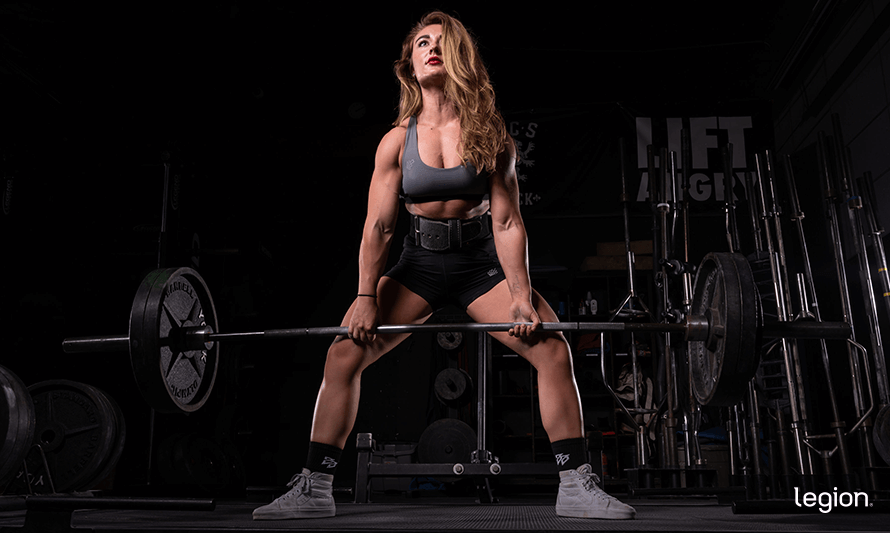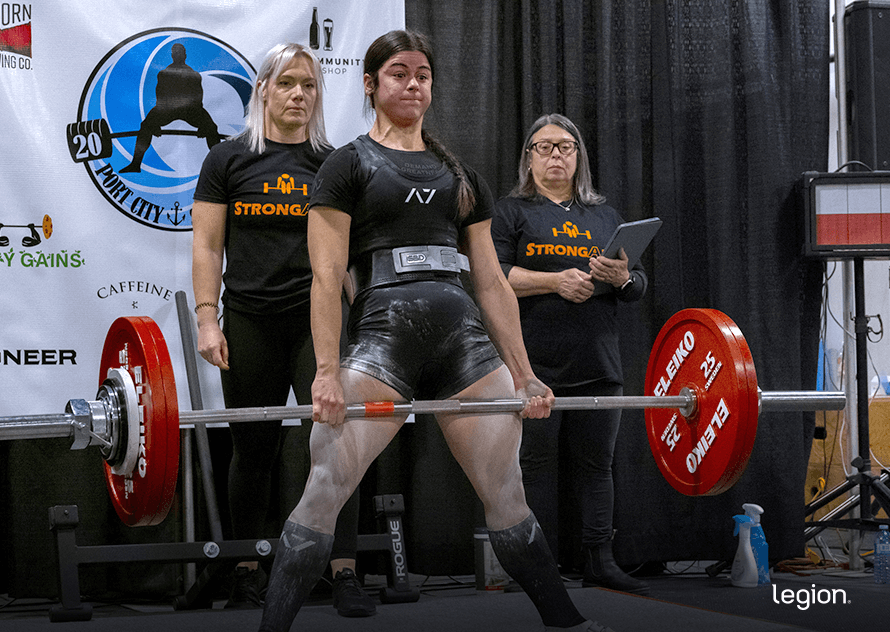You’ve been deadlifting for months, maybe years, and the gains have been great—until now.
Suddenly, the bar feels glued to the ground, locking out becomes a grind, and progress slows to a crawl or stops altogether.
Sound familiar?
At this stage, doing more deadlifts likely won’t fix the problem. A better strategy is incorporating deadlift accessory exercises.
These specialized movements strengthen your weak points, build muscle, and burnish your technique, helping you break through plateaus and deadlift more weight.
In this article, you’ll discover the eight best deadlift accessory exercises and how to program them for maximum results.
Key Takeaways
- A deadlift accessory exercise is any movement that strengthens the muscles and mechanics involved in the deadlift.
- They don’t replace the deadlift but rather complement it by targeting your weak points, improving your form, and helping you lift more weight.
- Choose deadlift accessory exercises that address your specific weaknesses. The idea is to help you break through plateaus and improve your deadlift performance.
- Most gymgoers should perform accessory workouts for the deadlift once per week, focusing on 1-to-2 exercises that strengthen your specific weaknesses.
- To get the most out of your accessory work, end every set 1-to-3 reps of failure, swap accessory exercises every 8-to-12 weeks, and prioritize proper technique.
What Is a Deadlift Accessory Exercise?

A deadlift accessory exercise is any movement that strengthens the muscles and mechanics involved in the deadlift.
In other words, deadlift accessories don’t replace the deadlift but rather complement it by targeting weak points, improving form, and helping you lift more weight.
For the most part, the best way to improve your deadlift is to deadlift. This won’t work forever, though. Eventually, progress stalls because weaknesses in specific parts of the lift—like breaking the bar off the floor or locking out—start to hold you back.
At this stage, incorporating accessory lifts for the deadlift that address your weaknesses is an excellent way to get progress back on track.
The 8 Best Deadlift Accessory Exercises for Boosting Pulling Power
Here are the eight best accessories for the deadlift.
They work so well because they mimic the regular deadlift’s movement pattern and train the same muscles. Importantly, however, each allows you to emphasize different parts of the movement, so you can target and improve your weaknesses.
They also let you train with heavy weights and apply progressive overload, which makes them ideal for gaining strength that translates to better deadlift performance.
1. Romanian Deadlift
Why: The Romanian deadlift (RDL) is one of the best deadlift accessory exercises because it strengthens the lower back, glutes, and hamstrings and reinforces a proper “hip hinge” (keeping your back straight and pushing your butt back to lower your chest toward the floor).
The RDL is also less fatiguing than regular deadlifts. While many people can’t recover from deadlifting twice a week, they can often handle a combination of deadlifts and RDLs.
How to:
- Stand holding a barbell with a shoulder-width overhand grip (palms facing you).
- Hinge at your hips, keeping your back flat, and lower the bar in a straight line, letting your hips move backward.
- When you feel a stretch in your hamstrings, bend your knees slightly and keep lowering the barbell until your back begins to round.
- Reverse the movement and return to the starting position.
Expert Tip: To ensure your glutes and hamstrings do the lion’s share of the work, focus on pushing your hips backward rather than bending over. A good cue for this is “close the door.” The idea is to imagine you’re trying to nudge a door closed with your butt.
Programming Recommendations: The Romanian deadlift emphasizes the hamstrings more than a traditional deadlift, making it the gold standard for building hamstring strength and size. Train in the 4-to-6 (men) or 8-to-10 (women) rep range and incorporate it on a secondary deadlift day.
For instance, you could deadlift on Tuesday, then perform the RDL on Friday.
RELATED: The Only 5 RDL Variations You Need for Glute and Back Growth
2. Pause Deadlift
Why: The pause deadlift is an excellent accessory exercise for deadlift day because of its high carry-over to the deadlift. It’s basically the same as the regular deadlift except you pause for 1-to-2 seconds at the point in the range of motion where you’re the weakest.
For instance, if you’re weakest as the bar leaves the floor, you’d pause once the weights are around an inch off the ground. Or, if your main problem is pulling through the middle of the range of motion, you might pause just below knee height.
Pausing as you lift the weight trains your muscles to become stronger in this position, which should increase your performance when you return to regular deadlifting.
How to:
- Place your feet slightly narrower than shoulder-width, with your toes pointed out.
- Position a barbell about an inch from your shins over your midfoot.
- Take a deep belly breath, and grip the bar just outside your shins with palms facing you.
- Flatten your back, then drive upward and slightly back by pushing through your heels.
- When the bar reaches your weak point, pause for 1-to-2 seconds.
- Continue pulling until you’re upright.
- Reverse the movement without pausing and return to the starting position.
Expert Tip: As a general rule, sumo deadlifters are usually weakest off the floor, while conventional deadlifts typically fail as the bar travels between the mid-shin and knee. With that in mind, most sumo deadlifters should pause just after the weights leave the floor and conventional deadlifts should pause a little higher.
Programming Recommendations: To get the most out of the pause deadlift, it’s often best to perform it instead of the regular deadlift for an extended period. For example, you could replace the conventional deadlift with the pause deadlift for 8-to-12 weeks of training.
When you go back to pulling conventionally, your previous weakness should be significantly less pronounced.
3. Deficit Deadlift
Why: The deficit deadlift is an outstanding deadlift accessory exercise because it increases the exercise’s range of motion, helping you gain strength where many weightlifters are weakest—in the initial pull off the floor.
It also gives you a psychological boost when you go back to regular deadlifting, since pulling from the floor feels easier after a period of deadlifting from a deficit.
How to:
- Stand on a weight plate and place your feet slightly narrower than shoulder-width apart with toes pointed out.
- Position a barbell about an inch from your shins over your midfoot.
- Take a deep belly breath, and grip the bar just outside your shins with palms facing you.
- Flatten your back, then drive upward and slightly back by pushing through your heels until upright.
- Reverse the movement and return to the starting position.
Expert Tip: Use a platform or plates that create a 1-to-3-inch deficit. Going higher than this is unnecessary and can make it harder to maintain proper form.
Programming Recommendations: The deficit deadlift is an advanced deadlift accessory, so you should only attempt it if you can get into the correct starting position and maintain perfect form throughout each rep. Use the same set and rep scheme as the regular deadlift: 3-to-4 sets of 4-to-6 reps.
READ MORE: How to Do the Deficit Deadlift to Boost Pulling Strength
4. Block Pull (Rack Pull)
Why: Block pulls are the best deadlift accessories for emphasizing the top portion of the lift: the “lockout.” Their shorter range of motion also makes them excellent for working around injuries that make regular deadlifting uncomfortable.
How to:
- Place a barbell on blocks so the bar is off the floor but below knee height.
- Position your midfoot under the bar, with your feet slightly narrower than your shoulder width and your toes slightly turned out.
- Bend over and grab the bar with an overhand grip just outside your shins.
- Flatten your back and push through your heels to stand up straight.
- Reverse the movement and return to the start.
Expert Tip: Set the blocks or the safety bars on a power rack at a height that positions the bar just below your “sticking point” (the part of the range of motion where you usually fail a rep). For example, if you struggle as the bar passes your upper shin, set the bar slightly lower at mid-shin height.
Programming Recommendations: Block pulls are ideal for gaining raw strength, so perform them in a low rep range like 3-to-5 or 4-to-6.
RELATED: Rack Pulls: Benefits, Form & Variations
5. Barbell Good Morning
Why: The good morning is an excellent deadlift accessory exercise because it reinforces the hip-hinge movement, similar to the Romanian deadlift. However, due to the bar position, the good morning is better at strengthening the lower and mid back—a common weak point for many lifters.
How to:
- Place a barbell on your upper back, resting it across your traps, and grip the bar slightly wider than shoulder-width.
- Stand with your feet shoulder-width apart, toes pointing forward or slightly out.
- Brace your core, keep a slight bend in your knees, and hinge at your hips, pushing your hips back as your torso leans forward.
- Lower your chest toward the floor while keeping your back flat and tension in your hamstrings.
- Once you feel a stretch in your hamstrings, push through your heels and drive your hips forward to return to the starting position.
Expert Tip: Experiment with bar placement to find what works best for you. Resting the bar on your upper traps (high-bar position) or rear delts (low-bar position) are both effective options. If you have access to a safety squat bar or cambered bar, these can also make the movement more comfortable and stable.
Programming Recommendations: Good mornings are harder than they look, so start light and build strength gradually. They work best in a higher rep range, such as 6-to-10 reps per set.
READ MORE: How to do the Barbell Good Morning: Form, Benefits, and Alternatives
6. Trap-Bar Deadlift
Why: The trap bar deadlift is one of the best accessories for the deadlift because the movement pattern is almost identical, but it reduces stress on your lower back. Another unique benefit is that you can pull trap bars faster than barbells, which means trap-bar deadlifts are better for developing explosive power.
How to:
- Position your feet shoulder-width apart in the center of the trap bar.
- Hinge at your hips, slightly arch your lower back, and grip the handles.
- Push through your heels to drive your body upward and slightly back.
- Reverse the movement and return to the starting position.
Expert Tip: Trap bars typically have two sets of handles: High handles and low handles. The low handles extend the exercise’s range of motion, making it more challenging. In contrast, the high handles shorten the range of motion and take strain off your lower back. Choose whichever suits your goals best.
Programming Recommendations: The trap bar deadlift is a highly versatile accessory. You can perform it as a main deadlift variation in the 4-to-6 rep range or as an accessory exercise in a slightly higher rep range like 6-to-8.
READ MORE: How to Trap-Bar Deadlift with Proper Form (with a Free 12-Week Training Plan!)
7. Snatch-Grip Deadlift
Why: The snatch-grip deadlift is one of the best exercises for building the deadlift because the wider grip forces you to pull from a lower starting position, increasing the range of motion. It’s similar to a deficit deadlift but with one significant difference—the wide grip forces the traps and upper back to work harder to maintain proper posture.
How to:
- Place your feet slightly narrower than shoulder-width, with your toes pointed out.
- Position a barbell about an inch from your shins over your midfoot.
- Take a deep belly breath, and grip the bar with a snatch grip, your palms facing you.
- Flatten your back, then drive upward and slightly back by pushing through your heels until upright.
- Reverse the movement and return to the starting position.
Expert Tip: Find the right width for your snatch grip by standing upright and holding a barbell at a width that places it in your hip creases when your arms are straight.
Programming Recommendations: The snatch-grip deadlift is significantly less taxing than the regular deadlift because it forces you to lift much lighter weights. This means you can usually do the snatch-grip deadlift in addition to your regular deadlifting.
For example, you could perform regular deadlifts on Tuesday and include snatch-grip deadlifts in your Friday workout.
8. 45-Degree Back Extension
Why: The 45-degree back extension is an underrated deadlift accessory exercise because it safely trains the lower back, glutes, and hamstrings.
The main issue is that most people don’t use enough weight to maximize its benefits. While holding a 25-pound plate might seem sufficient, most weightlifters need to use heavier weight to truly see results.
How to:
- Position yourself on a 45-degree back extension bench with the pad resting just below your hip creases and your feet secured on the footplate.
- Cross your arms over your chest or hold a weight.
- Maintaining a flat back, hinge at the hips to lower your chest toward the floor.
- Reverse the movement and return to the starting position.
Expert Tip: Positioning the pad higher than your hip creases increases the odds you’ll round your lower back. While this isn’t always dangerous, it may increase injury risk and likely reduces the exercise’s effectiveness.
Programming Recommendations: As a general rule, place back extensions toward the end of an accessory workout for deadlifts and train them in a higher rep range like 8-to-10 or 10-to-12.
How to Choose the Right Deadlift Accessory Exercises for You

The beauty of a list like this is that it lets you tailor your training to your specific needs.
Not every exercise in the article will improve your deadlift. The best deadlift accessory exercises for you must be specific to your weaknesses.
Here is a rundown of the most common weaknesses and the exercises that help you overcome them
Weak Off the Floor
If you struggle with the first part of the lift, these three deadlift accessories are the most likely to help:
- Deficit deadlift
- Pause deadlift
- Snatch-grip deadlift
Weak at Lockout
If you have trouble finishing the top part of each rep, focus on these:
- Rack pull
- 45-degree back extension
Lacking Posterior Chain Muscle
All else being equal, a bigger muscle is a stronger muscle. Use these four deadlift assistance lifts to add mass to your posterior chain:
- Romanian deadlift
- Trap-bar deadlift
- Good morning
- 45-degree back extensions
Hip Hinge Issues
Mastering the hip hinge is crucial for a strong deadlift. These accessory exercises will help:
- Romanian deadlift
- Good morning
How to Organize Accessory Workouts for the Deadlift
You can program accessory workouts for the deadlift in countless ways, but for most people, a straightforward strategy is to do your main deadlift in a back, pull, or upper body workout early in the week, then include 1-to-2 deadlift assistance exercises in a leg or lower body workout later in the week.
Here’s how that might look:
Workout #1:
- Deadlift: 3 sets | 4-to-6 reps | 3-to-5 min rest
- Pull-ups: 3 sets | 4-to-6 reps | 2-to-3 min rest
- One-Arm Dumbbell Row: 3 sets | 6-to-8 reps | 2-to-3 min rest
- Barbell Curl: 4 sets | 6-to-8 reps | 2-to-3 min rest
Workout #2
- Barbell Back Squat: 4 sets | 4-to-6 reps | 3-to-5 min rest
- Romanian Deadlift: 4 sets | 4-to-6 reps | 2-to-3 min rest
- Leg Press: 3 sets | 6-to-8 reps | 2-to-3 min rest
- 45-Degree Back Extension: 3 sets | 8-to-10 reps | 1-to-2 min rest
5 Tips to Maximize Your Deadlift Accessory Work
1. End every set 1-to-3 reps shy of muscle failure.
As I explain in my fitness books for men and women, to maximize your results, you must take most sets of deadlift accessory exercises to within a rep or two of failure.
To gauge whether you’re reaching this point, ask yourself at the end of each set: “If I had to, how many more reps could I have done with good form?”
If the answer is more than three, increase the weight or reps on your next set to make it more challenging.
2. Once you hit the top of your rep range for a set, move up in weight.
If your workout calls for 4-to-6 reps of the deadlift and you get 6 reps for a set, add 10 pounds to your next set.
If you do 3 reps or fewer in subsequent sets, reduce the load by 5 pounds to stay in the 4-to-6 rep range.
Apply this approach to every deadlift accessory exercise in your routine, aiming to add either weight or reps every session.
3. Substitute accessories for the deadlift every 8-to-12 weeks.
Change your deadlift accessory exercises every 8-to-12 weeks to target your biggest weaknesses and keep your progress on track. You can also occasionally swap out your main deadlift to focus on specific sticking points.
For example, if your progress slows because you’re struggling with the initial pull off the floor, replace the conventional deadlift with deficit deadlifts for your next 8-to-12-week training block.
4. Prioritize Technique
Deadlift accessories often feel very different from regular deadlifts. For instance, pause deadlifts require more precise timing to be effective.
This means that being a proficient deadlifter doesn’t guarantee you’ll excel at every accessory exercise right away. To prevent injuries and maximize results, take the time to learn proper technique before adding them to your routine.
5. Take the right supplements.
These supplements can help you optimize your performance and gains while performing deadlift accessory lifts:
- Protein powder: Protein powder, such as whey or casein, provides your body with the nutrients needed to build muscle tissue and recover from workouts.
- Creatine: Creatine supplements, such as creatine monohydrate powder and gummies, boost muscle and strength gain, improve anaerobic endurance, and reduce muscle damage and soreness from your workouts.
- Pre-workout: A high-quality pre-workout enhances energy, mood, and focus, increases strength and endurance, and reduces fatigue.
FAQ #1: How often should you do accessory exercises for the deadlift?
Unless you’re a competitive powerlifter, it’s usually best to perform deadlift accessory exercises once per week in addition to your regular deadlifting. For example, if you deadlift early in the week, perform 1-to-2 deadlift accessories as part of a leg or lower body workout later in the week.
FAQ #2: What’s the best accessories for the sumo deadlift?
Many sumo deadlifters struggle to generate strength off the floor. As such, pause, deficit, and snatch-grip deadlifts are generally the best accessories.
FAQ #3: Is leg press a good deadlift accessory?
The leg press can be a good deadlift accessory. It strengthens the quads, hamstrings, and glutes, which are important muscles for deadlift performance. However, it is not specific enough to the deadlift to be one of the best accessory exercises.
RELATED: How to Do the Leg Press: Benefits, Form, & Alternatives
Scientific References +
- Lake, Jason, et al. “Effect of a Hexagonal Barbell on the Mechanical Demand of Deadlift Performance.” Sports, vol. 5, no. 4, 24 Oct. 2017, p. 82, https://doi.org/10.3390/sports5040082.
- Stokes, Tanner, et al. “Recent Perspectives Regarding the Role of Dietary Protein for the Promotion of Muscle Hypertrophy with Resistance Exercise Training.” Nutrients, vol. 10, no. 2, 7 Feb. 2018, p. 180, www.mdpi.com/2072-6643/10/2/180/pdf.

